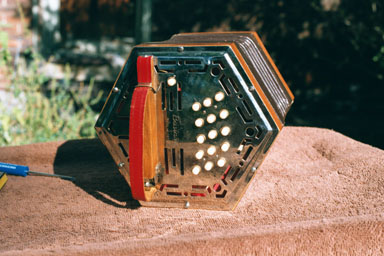
Many of you have heard the stories of heirloom concertinas discovered at sales or in shops for only a few dollars or pounds. These stories all either took place a generation ago or are apocryphal. You may have concluded this will never happen to you. Well, a recent experience of mine suggests there are bargains of a different sort to be found now and then.
Some time ago, I stopped into an antique store in a small town not too far from where I live. I spend a lot of time scrounging in such shops, though it is rare that I purchase anything. In one display case was a 30-button anglo that looked like an Italian W-15 model, labeled "Bastari concertina." I asked to see it, but I was really just engaging in idle curiosity. The air button didn't seem to let any air in or out, the buttons stuck in the expected way, the five-fold bellows were extremely stiff, and some of the notes were weak sounding. While I was playing and talking to some other folks in the shop the manager had, unknown to me, called the seller of the concertina. (Antique shops here commonly are "malls," that is, they have small display areas rented by individual, absentee, sellers.) This concertina must have been on offer for quite a while (a good reason to not visit the local shop *too* often?), as the seller came down to a price much less than I expected without me even asking. For that price I was sure I could at least resell it, so I bought it.

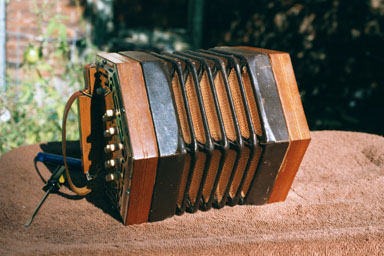
When I had a chance to open the concertina up, I found some surprises. To put this in context, we need to review the more typical anatomy of an Italian concertina.
Yes, Italy is a great place to study anatomy - whatever sort interests you! Since I'm not aware of any photos of typical Italian instruments on concertina.net, I took some.
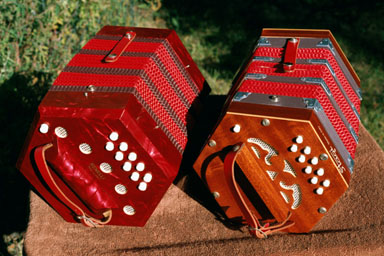
On the left is an old, out of tune C/G Renelli (circa 1960s) that I got for US $50 in 1992 as my first concertina, and on the right is the C/G Stagi (probably a B-2 model?) that I got new in 1996. Both these have octave reeds, two reeds per button pitched an octave apart. Nice sound, but slow to speak.
Incidentally, these were my sole instruments until I got a Lachenal in late 1998. I used the Stagi for two years at Noel Hill concertina school and still learned quite a bit! I still play it once in a while, but only if the musical situation calls for quiet backup chords.
Let's look inside.
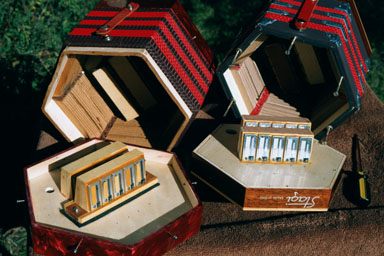
Here you see the reed boxes, somewhat like a button accordion. The reed plates are waxed in and must be removed for tuning, valve replacement, etc. I'm told that the reeds not being flat against the sound board is part of the reason these concertinas don't sound like vintage English-built boxes but more like accordions.
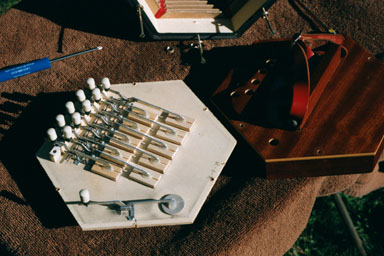
Here is the typical action, of light but easily deformed aluminum. One axle secures five levers.
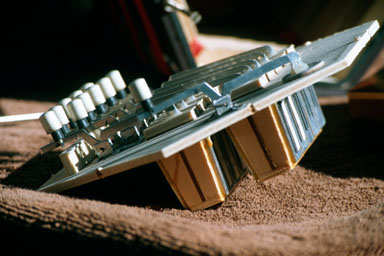
OK, now lets open up the newly-discovered Bastari.
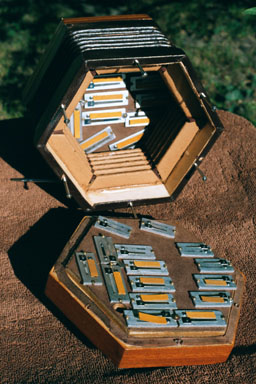
Surprise number one, it is completely different! Here the accordion reed plates are individually mounted flat against the sound board using screws.
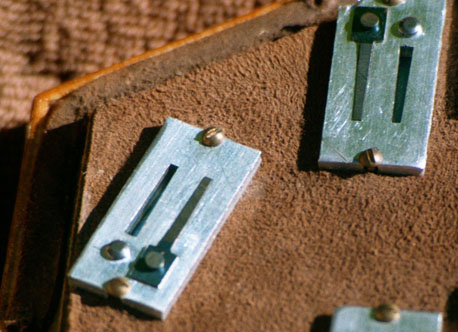
A leather gasket helps seal the reeds against the board. At least one major maker builds instruments this way today.
What then, does the action look like?
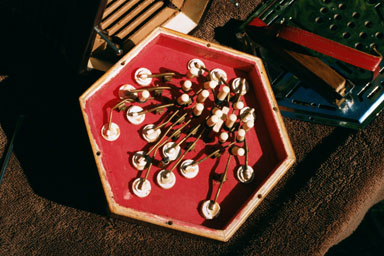
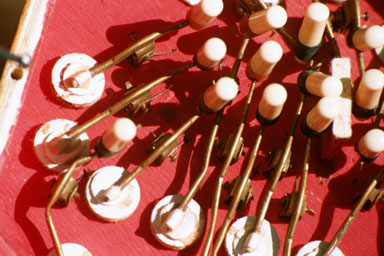
This surprise (number two) was even bigger. The buttons are on individual levers, with rivets! Well sort of...the rivets are sort of loose. Several pads looked to me like they were missing the wool and leather parts, including the air button, suggesting a simple repair. I later found they were thinner on purpose, to make all the buttons level.
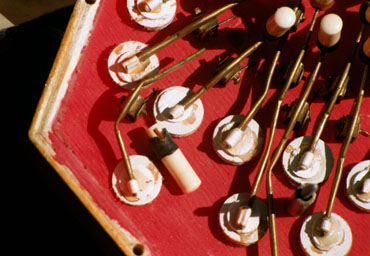
Note the floppy buttons with worn-out rubber sleeves. Many of you have worked on these and know what a troublesome design they are. OK, excuse me for twenty minutes while I struggle to get the end back on over all the loose crooked buttons...
While the tolerances and construction are not the equal of the Herrington-Morse-Norman-etc. class of instruments, the general design is similar. This Bastari is also a good deal more to my liking than the classic modern Italian anglo models I illustrated previously. If fixed up, I believe this instrument, while worth less than the $1200-$1850 accordion-reeded class, is certainly worth as much as (or more than?) a used Stagi W-15 ($350-$425 U.S.). And it's not an heirloom, so I'm not afraid to try fixing it up myself. I plan to repair the pads as necessary, get all the levers to the same height, and then throw away the old buttons and install Tedrow-type buttons. (Bob's photo essay on how to do this is entitled "How to Hot Rod and Upgrade your Stagi Concertina" at hmi.homewood.net.) I'm using 1/4 inch Delrin (from the McMaster-Carr company) rather than 3/16 inch brass. The instrument's potential should be evident then. It is in pretty good tune with itself, but oddly enough at about A=444, or about 15 cents sharp. I wonder why? So retuning might be in order. New valves would probably be worth the effort. I might even try building a better bellows if I can't get the folded cardboard ones to work better.
The moral then, is keep your eyes open. You never know what you will find. I come across lots of more common band and folk instruments in my area that are in good shape and priced at a small fraction of their value -- I am getting so many in my house that I may have to go into the musical instrument trade! But I'm not urging all of you to run out and buy every old instrument you find either; remember to consider price. If this instrument had cost hundreds of dollars, I would not have bought it unless I could look inside first. The more expensive it is, the less willing I am to gamble on what I am getting.
It's both gratifying and fun to find at least one Italian concertina worth some effort to restore. After all, Italy is justly famed for its accordions, Opera, architecture, museums, Renaissance music, wine, fashion, etc. I visited Italy for the first time in the summer of 2001 (the Alps and Tuscany) and loved it. I hope to return to see more, musical and otherwise.
Finally, I'm curious about Dr. Bastari and his instruments, as I've heard that some of his other models were similarly better-than-average. Can anyone out there tell us more, about this instrument or his work in general? One person I spoke to speculated that this might have been a prototype. If so, how did it get to rural Indiana? All the parts of this concertina are marked with the number 52X. Is this an assembly number or an actual serial number? This may be the sort of box Fred Quann refers to in his 1983 book, "A Handbook of the Concertina":
The so-called concertinas made in Germany and Italy ... are usually imitation anglo concertinas [and] ... are actually small accordions. The Italian anglo Bastari concertina does not fall under this classification as it is a real concertina and a **** good buy for the money." (page 11)
Are there any articles in the old Concertina and Squeezebox or Free Reed magazines about these instruments? I suspect if I had been playing concertina 25 years ago, I would know some of this information, but I would also have been able to buy a Jeffries for nothing and wouldn't be tempted to buy old Italian concertinas now!
Hearty thanks to everyone I spoke to while doing this investigation and planning the repairs: Dana Johnson, Rich Morse, Doug Creighton, Frank Edgley, and Bob Tedrow. And thanks as always to Paul Schwartz, our host!
April-May, 2003: George Salley sent in the following comments:
[Your Bastari's] end plates & buttons are identical to my 30b Bastari ca. 1979. The mechanisms are similar, if not identical, to my 40b Bastari ca. 1983 (see C&S Vol 1, No 3) Also the reed plates attach to the pan in a similar manner. After their disastrous Saxon 30b Anglo, I suspect that the Crawley Hobgoblins worked with Bastari, or maybe even cobbled together a "stock" 30b one.
I'm more than convinced it was an effort by the Dr himself [i.e. Dr. Bastari]. I gather that the 40b was not a success, probably because it was based on the 20b, used all new parts, and was big. After I got my Jeffries, I gave my 40b Bastari to Tony Davis of the Spinners UK. Since the 40b Bastari was marketed by Hobgoblin, they might be able to give you some info on yours.
[A good suggestion; I haven't followed up on it yet! --Ken]